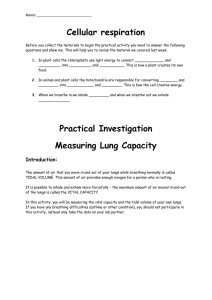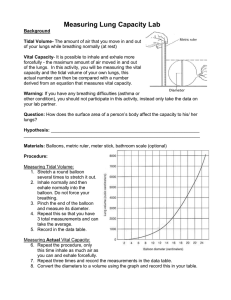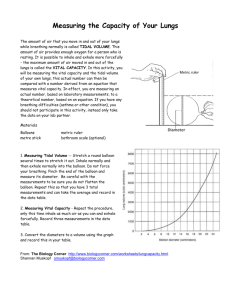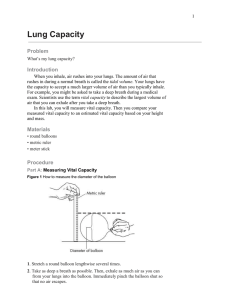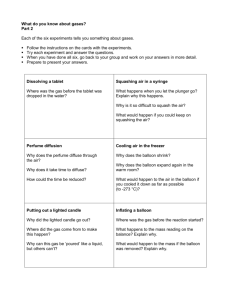Just Breathe
advertisement
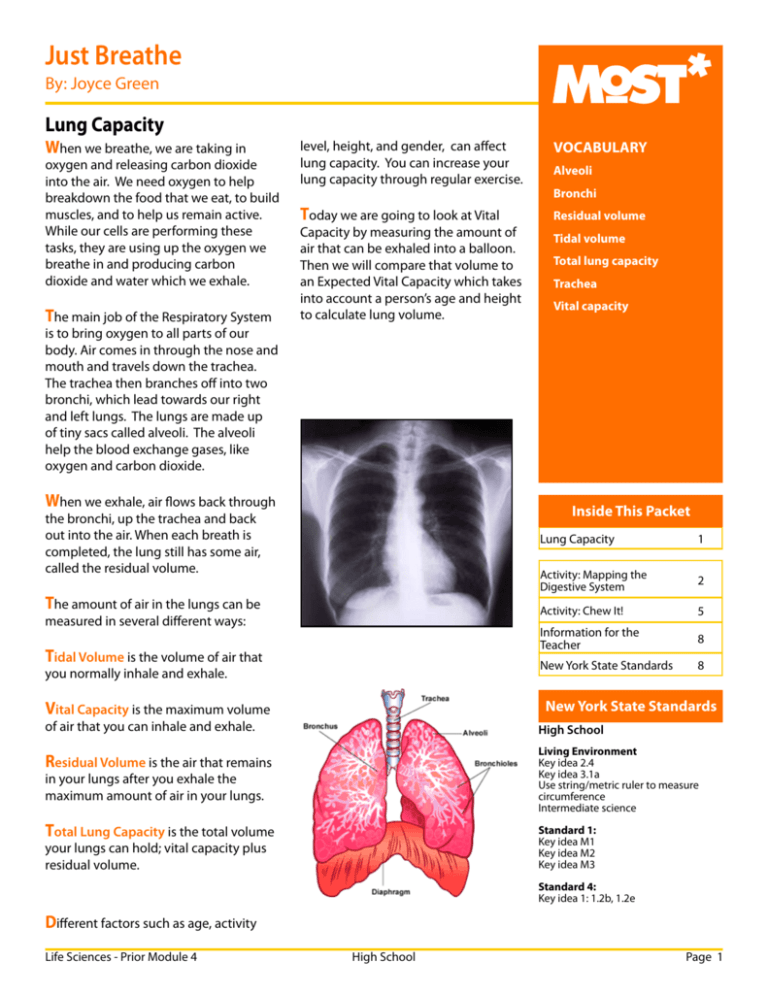
Just Breathe By: Joyce Green Lung Capacity When we breathe, we are taking in oxygen and releasing carbon dioxide into the air. We need oxygen to help breakdown the food that we eat, to build muscles, and to help us remain active. While our cells are performing these tasks, they are using up the oxygen we breathe in and producing carbon dioxide and water which we exhale. The main job of the Respiratory System level, height, and gender, can affect lung capacity. You can increase your lung capacity through regular exercise. VOCABULARY Today we are going to look at Vital Residual volume Capacity by measuring the amount of air that can be exhaled into a balloon. Then we will compare that volume to an Expected Vital Capacity which takes into account a person’s age and height to calculate lung volume. Alveoli Bronchi Tidal volume Total lung capacity Trachea Vital capacity is to bring oxygen to all parts of our body. Air comes in through the nose and mouth and travels down the trachea. The trachea then branches off into two bronchi, which lead towards our right and left lungs. The lungs are made up of tiny sacs called alveoli. The alveoli help the blood exchange gases, like oxygen and carbon dioxide. When we exhale, air flows back through Inside This Packet the bronchi, up the trachea and back out into the air. When each breath is completed, the lung still has some air, called the residual volume. Lung Capacity 1 2 The amount of air in the lungs can be measured in several different ways: Activity: Mapping the Digestive System Activity: Chew It! 5 Information for the Teacher 8 New York State Standards 8 Tidal Volume is the volume of air that you normally inhale and exhale. Vital Capacity is the maximum volume New York State Standards of air that you can inhale and exhale. High School Residual Volume is the air that remains Living Environment Key idea 2.4 Key idea 3.1a Use string/metric ruler to measure circumference Intermediate science Total Lung Capacity is the total volume your lungs can hold; vital capacity plus residual volume. Standard 1: Key idea M1 Key idea M2 Key idea M3 in your lungs after you exhale the maximum amount of air in your lungs. Standard 4: Key idea 1: 1.2b, 1.2e Different factors such as age, activity Life Sciences - Prior Module 4 High School Page 1 Activity: 1-2-3 Blow! MATERIALS NEEDED Large balloon String Measuring tape or meter stick Student Worksheet What to do: 1. With a partner to complete the activity. One person will record the measurements (data collector) and the other will blow up the balloon (test subject). If you have asthma or any other lung condition, have your partner blow up the balloon. 2. Test subject - Stretch the balloon and blow it up several times before you begin taking measurements. 3. Test subject - Take a deep breath and exhale as much air as you can into the balloon in ONE BREATH. Pinch the opening shut with your fingers. Students should be able to: Calculate their total lung capacity, vital capacity and residual volume. 4. Data collector - Take the string and wrap it around the widest part of the balloon. Place the string on the meter stick and record the length of the string in centimeters. This will give us the circumference of the balloon. Record this value under Trial 1 in Table 1 on your worksheet. 5. Repeat this 4 times for a total of 5 trials. 6. Calculate the average circumference of your 5 trials and record this value in Table 2. 7. Calculate the diameter of the balloon using the following formula then record your result in Table 2. Diameter= circumference / pi pi= 3.14 8. Calculate the radius of the balloon using the following formula then record your result in Table 2. Radius= diameter/ 2 9. Calculate the volume of air in the balloon using the following formula then record your result in Table 2. Volume = radius3 x pi x ¾ 10. Convert the volume of air (mL) to volume of air (L) or Experimental vital capacity using the following formula then record your results in Table 2. Volume (L)= Volume (mL) / 1000 The volume of air you calculated is your Experimental Lung Capacity, or the amount of air your lungs actually held. We can also calculate your Vital Capacity, or the amount of air your lungs should hold when based on your height and age. 11. Calculate your height in cm using the following formula then record your results in Table 3. Height in cm= height in inches x 2.54 12. Calculate your expected vital capacity using the following formula then record your result in Table 3. Vital Capacity = 0.041 x height (in cm) – 0.018 x your age – 2.69 Life Sciences - Prior Module 4 High School Page 2 Activity: 1-2-3 Blow! Student Worksheet Name: _______________________________ Name: _______________________________ Date: ________________ Table 1: Circumference of the Balloon Trial 1 Trial 2 Trial 3 Trial 4 Trial 5 Radius of the Balloon Volume of Air in ML Volume of Air in L Height in CM Expected Vital Capacity in L Experimental Vital Capacity (from Table 2) Table 2: Calculated Values Average Circumference Diameter of the Balloon Table 3: Expected Vital Capacity Age in Years Height in Inches Questions 1. How does your expected vital capacity compare to your calculated vital capacity? ______________________________________________________________________ ______________________________________________________________________ ______________________________________________________________________ ______________________________________________________________________ 2. Why might the experimental vital capacity be different than the calculated vital capacity? ______________________________________________________________________ ______________________________________________________________________ ______________________________________________________________________ 3. Compare your experimental vital capacity with other students in your class. Are they the same or different Explain your answer. ______________________________________________________________________ ______________________________________________________________________ ______________________________________________________________________ ______________________________________________________________________ Life Sciences - Prior Module 4 High School Page 3
